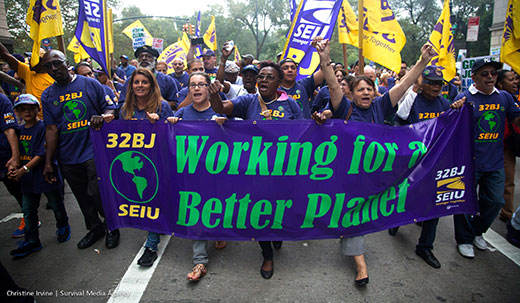
WASHINGTON – Despite continuing, sometimes successful, efforts to bridge the gap between greens and blues, rifts occur from time to time. It’s a byproduct of our dog-eat-dog system in which macroeconomic planning is virtually impossible.
Greens work to put in place programs and policies aimed at protecting and sustaining the environment over the long haul. Blue collar workers must support themselves and their families in the here and now.
For example, environmentalists point out that switching the nation from dependency on fossil fuels to sustainable solar, wind and geo thermal power could help avert disaster caused by global climate change.
Coal miners ask: “What’s to become of us?”
Donald Trump, in typical Trump fashion, is taking advantage of coal miners’ fears. In speeches across Appalachia he’s pledged not to switch energy sources. “You’ll be working your asses off;” he’s said. He has not said that under a Trump administration, coal miners would work without union rights, union wages or union safety protections.
If our system were rational, we would definitely switch to sustainable energy and the government would provide compensation, alternative employment and re-training to all workers displaced because of the switch to sustainable energy. In our society, except for minimal aid, it’s devil take the hindmost unless there’s a major push from voters and a commitment from government to buck unbridled ‘free enterprise.”
The latest green vs. blue conundrum has taken the form of a dispute between labor leaders.
The issue grew out of a plan by the AFL-CIO to launch a get-out-the-vote drive to defeat Trump and support progressive candidates. AFL-CIO President Richard Trumka turned to a wealthy San Francisco businessman to help finance the program.
That’s when the controversy kicked in.
The businessman is Tom Steyer, an environmental activist who, among other things, opposes the construction of the Keystone oil pipeline.
Environmentalists see the pipeline as a major threat to the ecology of thousands of miles of land from the Gulf Coast to Canada. Construction workers see badly-needed jobs.
The U.S. could create long lasting, high paying construction jobs through programs to rebuild our deteriorating infrastructure, but funding for such projects has been continuously blocked by right wingers who control the House and Senate. As a result, instead of there being virtual full employment in the construction industry, the number of construction jobs has been declining.
No wonder construction workers and their representatives back the Keystone pipeline. No wonder they resent people like Steyer who have worked to block it.
What’s worse, Steyer is a hedge fund manager, a member of the group that helped bring down our national economy in 2008.
Objecting to the partnership between the AFL-CIO and Steyer, Terrence O’Sullivan, president of the 500,000-member laborers’ union, wrote in a letter to Trumka that “We object to the political agenda of the A.F.L.-C.I.O. being sold to a job-killing hedge fund manager with a bag of cash.”
Ironically, both the laborers’ union and Steyer support Hillary Clinton, who recently changed her position and, along with President Obama, now opposes the construction of the pipeline.
In his letter to Trumka, O’Sullivan said “The Laborers’ International Union of North America is proud to be one of Hillary Clinton’s strongest supporters, all without taking a dime from anyone outside our union … “
O’Sullivan also alluded to the fact that the American Federation of State, County and Municipal Employees support the partnership with Steyer, as do the nation’s two largest teachers’ unions.
“I have heard many other labor leaders say that if we want progressive organizations to be there for us on our issues, we need to be there for them on their issues,” O’Sullivan wrote. “But we’re not going to hold hands, sing Kumbaya, and support positions that threaten the jobs, livelihoods and economic health of our dues-paying members … .
“Our primary responsibility as union leaders is to our members …”
Furthermore, O’Sullivan signed another letter to Trumka. This one was from the presidents of eight construction workers unions and it sums up the quandary faced by workers whose jobs are threatened by new, albeit environmentally sound policies.
“We are not climate science deniers,” the union presidents wrote. “[We] have merely sought to ensure that the employment prospects of our members are not negatively impacted in any economic and energy transition.”
Both Hillary Clinton and Bernie Sanders have said that a national priority must be aiding workers displaced by the adoption of national policies promulgated to protect the future of our environment. Trump takes no such position in support of workers hurting from displacement.
Moreover, both Clinton and Sanders have pledged to support funding for rebuilding the infrastructure of the U.S., which would create hundreds of thousands of building trades jobs.
If these goals are achieved, no worker in the U.S. would feel threatened by new, environmentally sound policies. And the workers’ union representatives would no longer be put in the untenable, unenviable position of having to fight for short-term goals that might work against the long-term health of our environment.
If these goals had been achieved by now, union leaders would not have felt compelled to object to partnering against Trump with people like Steyer because they support environmental causes.
The union leaders might object to partnering with people like Steyer because they manage economically inequitable institutions like hedge funds, but that’s another matter.
Photo: Some unions, like Local 32BJ of the Service Employees, have been in the forefront of the fight for environmental justice. Here union members march in the Peoples Climate March in New York, Sept., 2014. | Christine Irvine/People’s Climate March/Flickr












Comments